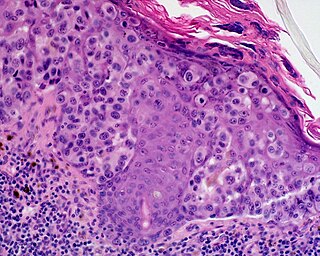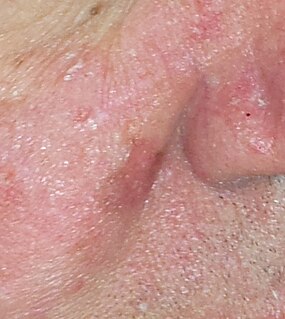
Freckles are clusters of concentrated melaninized cells which are most easily visible on people with a fair complexion. Freckles do not have an increased number of the melanin-producing cells, or melanocytes, but instead have melanocytes that overproduce melanin granules (melanosomes) changing the coloration of the outer skin cells (keratinocytes). As such, freckles are different from lentigines and moles, which are caused by accumulation of melanocytes in a small area. Freckles can appear on all types of skin tones. Of the six Fitzpatrick skin types, they are most common on skin tones 1 and 2, which usually belong to North Europeans. However, it can be found in all ethnicities.

William Terence Kirby, popularly known as Dr. Will, is an aesthetic dermatologist, an associate clinical professor of dermatology, and a reality television personality. He is known for winning the CBS reality show Big Brother 2 as well as winning The Price Is Right and appearing on multiple medical television programs as an aesthetic dermatology expert.
Erythrasma is a superficial skin infection that causes brown, scaly skin patches. It is caused by Corynebacterium minutissimum bacteria, a normal part of skin flora.

Lentigo maligna melanoma is a melanoma that has evolved from a lentigo maligna, as seen as a lentigo maligna with melanoma cells invading below the boundaries of the epidermis. They are usually found on chronically sun damaged skin such as the face and the forearms of the elderly.

Lentigo maligna is where melanocyte cells have become malignant and grow continuously along the stratum basale of the skin, but have not invaded below the epidermis. Lentigo maligna is not the same as lentigo maligna melanoma, as detailed below. It typically progresses very slowly and can remain in a non-invasive form for years.
Carney complex and its subsets LAMB syndrome and NAME syndrome are autosomal dominant conditions comprising myxomas of the heart and skin, hyperpigmentation of the skin (lentiginosis), and endocrine overactivity. It is distinct from Carney's triad. Approximately 7% of all cardiac myxomas are associated with Carney complex.
Depigmentation is the lightening of the skin or loss of pigment. Depigmentation of the skin can be caused by a number of local and systemic conditions. The pigment loss can be partial or complete. It can be temporary or permanent.

Grover's disease (GD) is a polymorphic, pruritic, papulovesicular dermatosis characterized histologically by acantholysis with or without dyskeratosis. Once confirmed, most cases of Grover's disease last six to twelve months, which is why it was originally called "transient". However it may last much longer. Nevertheless, it is not to be confused with relapsing linear acantholytic dermatosis.
Mequinol, MeHQ or 4-methoxyphenol, is a phenol used in dermatology and organic chemistry.

Schamberg's disease, is a chronic discoloration of the skin found in people of all ages, usually only affecting the feet, legs or thighs or a combination. It may occur as a single event or subsequent bouts may cause further spread. It is most common in males. It is named after Jay Frank Schamberg, who described it in 1901. There is no known cure for this disease but it is not a life-threatening condition and is mainly of cosmetic concern, although, because it can appear so suddenly, so extensively and because it usually leaves permanent discoloration of the skin, it can cause understandable psychological concern. The skin lesions sometimes cause itching, which can be treated by applying cortisone cream. The cortisone cream will only help with the itching and does not improve the discoloration of the skin. Schamberg's disease causes no other symptoms beside skin discoloration and itching. The condition is caused by inflammation of capillaries near the surface of skin and subsequent leaking of red blood cells into surrounding tissues. As the red blood cells break down and get mostly resorbed, some of the iron released by the red blood cells remains in the skin and causes the characteristic rust-colored appearance. The cause of the capillary inflammation is usually unknown.
PUVA lentigines is a cutaneous condition caused by PUVA therapy.
Mucosal lentigines is a cutaneous condition characterized by light brown macules on mucosal surfaces.

Generalized lentiginosis is a cutaneous condition that will occasionally present without other associated abnormalities. It may be caused by carney complex, Noonan syndrome with multiple lentigines or Peutz–Jeghers syndrome.
Centrofacial lentiginosis is a cutaneous condition characterized by lentigines on the nose and adjacent cheeks.

Inherited patterned lentiginosis is an inherited skin condition that results in widespread small, flat areas of more-pigmented skin with clearly defined borders, generally noticed when the affected person is an infant or young child. The inheritance pattern is autosomal dominant, and organs other than the skin are not affected; therefore, it is distinct from Carney complex.
Partial unilateral lentiginosis is a cutaneous condition characterized by lentigines located on only one half of the body.

Paederus dermatitis, medically known as dermatitis linearis, is a skin irritation resulting from contact with the hemolymph of certain rove beetles, a group that belongs to the insect order Coleoptera and the genus Paederus. Other local names given to Paederus dermatitis include spider-lick, whiplash dermatitis, and Nairobi fly dermatitis.

Favre–Racouchot syndrome is a solar elastotic disorder consisting of multiple open comedones that occurs in skin damaged by sunlight, especially under and lateral of the eyes. The comedones are widened openings for hair follicles and sebaceous glands filled with material.
Electrodesiccation and curettage is a medical procedure commonly performed by dermatologists, surgeons and general practitioners for the treatment of basal cell cancers and squamous cell cancers of the skin. It provides desiccation, coagulation/cauterization, and curettage to remove lesions from the skin.
Tegumental angiomyxoma-neurothekeoma is a syndrome, an acronym, and eponym proposed by Malaysian ophthalmologist of Chinese Descent, Tan Aik Kah. Angiomyxomas are associated with LAMB syndrome, NAME syndrome and Carney syndrome.








